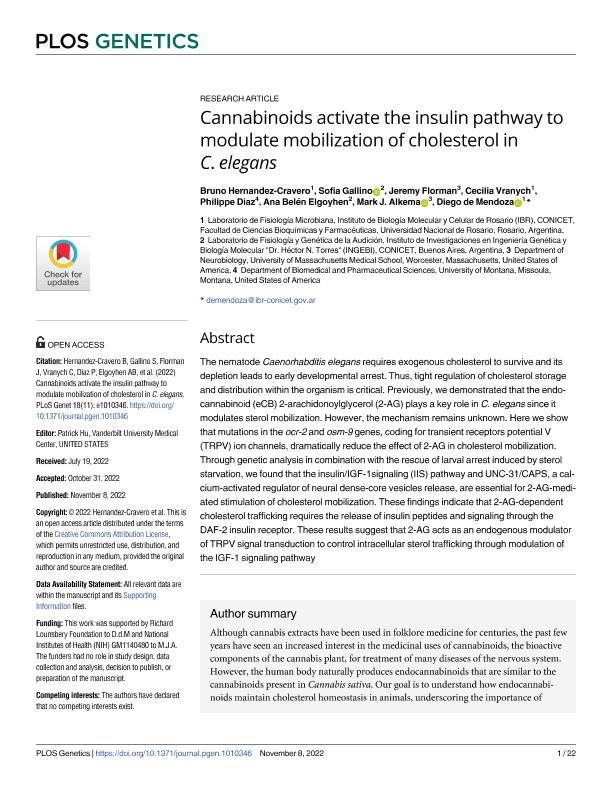Artículo
Cannabinoids activate the insulin pathway to modulate mobilization of cholesterol in C. elegans
Hernández Cravero, Bruno ; Gallino, Sofia Ludmila
; Gallino, Sofia Ludmila ; Florman, Jeremy; Vranych, Cecilia Verónica
; Florman, Jeremy; Vranych, Cecilia Verónica ; Diaz, Philippe; Elgoyhen, Ana Belen
; Diaz, Philippe; Elgoyhen, Ana Belen ; Alkema, Mark J.; de Mendoza, Diego
; Alkema, Mark J.; de Mendoza, Diego
 ; Gallino, Sofia Ludmila
; Gallino, Sofia Ludmila ; Florman, Jeremy; Vranych, Cecilia Verónica
; Florman, Jeremy; Vranych, Cecilia Verónica ; Diaz, Philippe; Elgoyhen, Ana Belen
; Diaz, Philippe; Elgoyhen, Ana Belen ; Alkema, Mark J.; de Mendoza, Diego
; Alkema, Mark J.; de Mendoza, Diego
Fecha de publicación:
08/11/2022
Editorial:
Public Library of Science
Revista:
Plos Genetics
ISSN:
1553-7390
e-ISSN:
1553-7404
Idioma:
Inglés
Tipo de recurso:
Artículo publicado
Clasificación temática:
Resumen
The nematode Caenorhabditis elegans requires exogenous cholesterol to survive and its depletion leads to early developmental arrest. Thus, tight regulation of cholesterol storage and distribution within the organism is critical. Previously, we demonstrated that the endocannabinoid (eCB) 2-arachidonoylglycerol (2-AG) plays a key role in C. elegans since it modulates sterol mobilization. However, the mechanism remains unknown. Here we show that mutations in the ocr-2 and osm-9 genes, coding for transient receptors potential V (TRPV) ion channels, dramatically reduce the effect of 2-AG in cholesterol mobilization. Through genetic analysis in combination with the rescue of larval arrest induced by sterol starvation, we found that the insulin/IGF-1signaling (IIS) pathway and UNC-31/CAPS, a calcium-activated regulator of neural dense-core vesicles release, are essential for 2-AG-medi-ated stimulation of cholesterol mobilization. These findings indicate that 2-AG-dependent cholesterol trafficking requires the release of insulin peptides and signaling through the DAF-2 insulin receptor. These results suggest that 2-AG acts as an endogenous modulator of TRPV signal transduction to control intracellular sterol trafficking through modulation of the IGF-1 signaling pathway.
Palabras clave:
NEMATODE
Archivos asociados
Licencia
Identificadores
Colecciones
Articulos(IBR)
Articulos de INST.DE BIOLOGIA MOLECULAR Y CELULAR DE ROSARIO
Articulos de INST.DE BIOLOGIA MOLECULAR Y CELULAR DE ROSARIO
Articulos(INGEBI)
Articulos de INST.DE INVEST.EN ING.GENETICA Y BIOL.MOLECULAR "DR. HECTOR N TORRES"
Articulos de INST.DE INVEST.EN ING.GENETICA Y BIOL.MOLECULAR "DR. HECTOR N TORRES"
Citación
Hernández Cravero, Bruno; Gallino, Sofia Ludmila; Florman, Jeremy; Vranych, Cecilia Verónica; Diaz, Philippe; et al.; Cannabinoids activate the insulin pathway to modulate mobilization of cholesterol in C. elegans; Public Library of Science; Plos Genetics; 18; 11; 8-11-2022; 1-22
Compartir
Altmétricas



